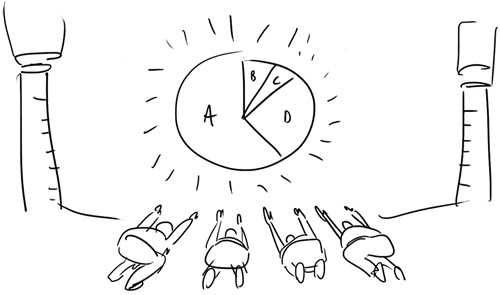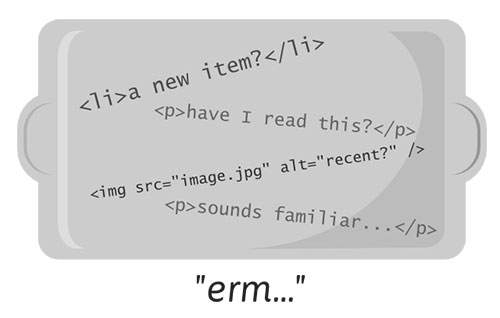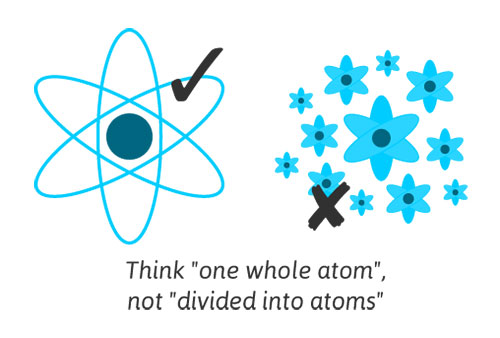How Google Search Works in 2016
Sharing is caring!
Please share 🙂
The below image has a somewhat small font size on it. You can see the full sized version by clicking here.
Many years ago we created an infographic about how search works, from the perspective of a content creator, starting with their content & following it through the indexing & ranking process.
As users have shifted to mobile devices, the limited screen size of the devices have pushed search engines to squeeze out & displace publishers with their own self-hosted information in an effort to offset the poor usability offered by tiny devices, while ensuring the search habit does not decline.
The philosophy of modern search has thus moved away from starting with information and connecting it to an audience, to starting with the user and customizing the result page to them.
“The biggest three challenges for us still will be mobile, mobile, mobile” – Google’s Amit Singhal
Powered by WPeMatico
Blog Promotion Strategies: How to Think Outside the Square
It’s day three of our thirty one day challenge!
How are you feeling? Pumped? Motivated? Ready to shake up your blog and your routine during these 31 days?
We’ve already covered nailing your elevator pitch and how to create a super-shareable list post, and today it’s all about getting yourself off your blog to promote it and find some readers.
“Build it and they will come“, you think? That is really not the case with blogging.
You need to put your blog where people will read it. In today’s podcast we discuss doing just that – how, where, and why to promote your blog with the maximum chances of it being seen. You have to get off your blog to get your blog read!
In todays episode there are tips on where to go to share your posts, how to build reader profiles (and why you need them), and how to figure out where those ideal readers are. Then we go through what to give those readers when you finally catch their attention – are you worthy of being found? How are you being useful? What kind of content are you creating?
Where are those potential readers?
The internet is vast, and while we immediately think of social media as the first place to share content, it isn’t always the only place.
In this episode we talk about developing editorial schedules for social media, but we also go beyond that, into the realm of guest posts, forums and other forgotten places to be seen.
We’re going to encourage you today to get off your blog and put yourself out there. Take today’s challenge and choose a certain post to share. All it takes is a little of your time and some creative thinking.
Click here to listen to day three of the 31 Days to Build a Better Blog series on the ProBlogger Podcast.
Let us know how you go with today’s challenge on twitter – just tag @ProBlogger and head to todays show notes to leave a comment.
Further Reading:
- How to Promote Your Blog Without Letting the Rest of Your Blogging Slide
- How to Promote Your Blog with Content that Will Grow your Traffic, Links, and Shares (especially helpful for business bloggers)
- Topsy.com helps you find influencers in your niche that you might be able to pitch to
- How to Promote Your Blog on Social Media – Hootsuite give some out-of-the-box ideas on leveraging the different streams of all the popular platforms
- Hubspot have an infographic on 36 Tried-and-True Ways to Promote Your Blog Posts
Don’t forget to subscribe to our podcast on iTunes and Stitcher to get updates of new episodes.
Blog Promotion Strategies: How to Think Outside the Square
http://www.problogger.net/archives/2015/07/03/blog-promotion-strategies-how-to-think-outside-the-square/
http://www.problogger.net/archives/category/31-days-to-building-a-better-blog/feed/
@ProBlogger » 31 Days to Building a Better Blog
Blog Tips to Help You Make Money Blogging – ProBlogger
http://www.problogger.net/wp-content/plugins/podpress/images/powered_by_podpress_large.jpg
One of the People that inspired me to be a Blogger
A couple years ago I was looking around for new opportunities and knew that I wanted to build my success on the internet. At the time I stumbled upon Darren …
Is The Internet Killing Creativity?
The internet is a wonderful place (mostly). An unprecedented revolution in communication, it continues to empower more people to publish and share their knowledge than any other phenomenon in history. It is a limitless playground of ideas and unbridled creativity. Or is it?

In 2014, Elliot Jay Stocks declared that designers have stopped dreaming. That we’ve stopped being creative. That every site looks the same. A crazy notion, considering the magnitude of tools and resources we have at our disposal. But Elliot’s been right before, and he’s not alone either.
The post Is The Internet Killing Creativity? appeared first on Smashing Magazine.
Powered by WPeMatico
Top 10 WordPress Security Myths
This guest post is by Anders Vinther of The WordPress Security Checklist.
WordPress Security is about as sexy as cleaning your house. And as a serious blogger, you already know that securing your site properly is not a trivial task.
That makes it a fantastic topic for myth fabrication.
In this post, I’ve compiled the top ten WordPress security myths for your easy consumption, followed by a light sprinkle of facts to debunk the myths.
Here are the myths:
- WordPress is not secure.
- Nobody wants to hack my blog.
- My WordPress site is 100% secure.
- I only use themes and plugins from wordpress.org so they are secure.
- Updating WordPress whenever I log in is cool.
- Once my WordPress site is setup my job is finished.
- I’ll just install xyz plugin and that’ll take care of security for me.
- If I disable a plugin or theme, there is no risk.
- If my site is compromised I will quickly find out.
- My password is good enough.
Myth 1. WordPress is not secure
When people experience security problems with their WordPress sites, they tend to blame WordPress. However, the WordPress core is very secure. And when a security hole is found, the development team is very quick to respond.
The most frequent causes for compromised WordPress sites are in fact:
- outdated software
- insecure themes and plugins
- bad passwords
- stolen FTP credentials
- hosting problems.
For more on this topic, see WordPress Security Vulnerabilities.
Myth 2. Nobody wants to hack my blog
Most hacking attempts are automated. There are rarely personal or political motives behind WordPress hacking—more often the motives involve financial gain.
Maybe you’re thinking, “But I don’t have anything for sale on my site. I don’t have credit card information or any other sensitive information. What could they possibly steal from my site?”
What you do have is resources.
Possible ways to exploit your site are:
- the insertion of spam links in your content to boost SEO for other sites
- through malware infections of your visitors computers, e.g. to steal their financial information
- redirecting your traffic to other sites.
For more details, see Are Small Sites Targeted For Hacking?
Myth 3. My WordPress site is 100% secure
No site that’s accessible on the internet will ever be 100% secure. Security vulnerabilities will always exist.
That is why you need a backup and recovery plan. If disaster strikes, you need to have a good backup available, and a plan for how to restore your site.
For more, see:
- WordPress Backup – The Plugin and The Plan
- How To Restore A WordPress Site
- The WordPress Rescue Plan
Myth 4. I only use themes and plugins from wordpress.org so they are secure
The WordPress Team reviews themes and plugins before they are included in the wordpress.org repository. However they do not have the resources to review updates.
Themes and plugins are developed by programmers from all over the world. Their experience and programming skills vary greatly, and so does the quality of their work. Even the best programmers make mistakes and all software contains bugs. Just pick a random plugin, look at the change log and you will see that bugs are routinely discovered and fixed. Even the best plugins developed by the most renowned people could contain undiscovered security risks.
Is it safer to get your themes and plugins from wordpress.org? Absolutely.
Is it guaranteed that there are no security problems with themes and plugins from wordpress.org? Absolutely not.
For more information, see:
- WordPress Plugin Management
- WordPress Theme Reviews
- Why You Should Never Search For Free WordPress Themes
Myth 5. Updating WordPress whenever I log in is cool
You need to keep WordPress core, plugins, and themes updated at all times. Whenever a security update is released the whole world can see what the problem was. This obviously exposes any site that has not been updated. Unless you log in to your WordPress admin dashboard every day, you’ll need a plugin that will notify you when updates are available.
More information can be found in the article, Update Notifications.
Myth 6. Once my WordPress site is set up, my job is finished
Having a WordPress site is an ongoing commitment—it’s like having a dog. As a bare minimum your WordPress blog needs to be maintained when new updates come out. This is crucial even if you do not write new posts or otherwise update the content.
If you simply leave your WordPress site behind like an abandoned holiday pet, chances are that you will be helping the bad guys carry out their malicious schemes to control the world. So if you will not or cannot keep your WordPress site updated, it’s better if you take it down!
Myth 7. I’ll just install xyz plugin and that’ll take care of security for me
You do need security plugins. And you need the right mix of security plugins. However, keeping your WordPress site secure goes well beyond what you install on your site.
Other factors you need to consider include:
- securing the computer you use to connect to your hosting account (anti-virus, malware and firewalls)
- creating and managing strong passwords
- using Secure FTP to access your hosting account
- protecting sensitive WordPress files from access from the internet
- off-site WordPress monitoring.
Myth 8. If I disable a plugin or theme, there is no risk
All files that exist in your WordPress folder are accessible from the internet unless you specifically protect them. This means even disabled themes and plugins can be exploited if they are vulnerable.
The best practice is to remove anything you do not use. Or, at a minimum, make sure you keep de-activated themes and plugins updated.
Myth 9. If my site is compromised I will quickly find out
Professional hackers are not interested in you finding out that your site has been compromised. Therefore you might not find out what has happened until quite some time after a hack has occurred—if you find out at all.
Some types of hacks that are difficult to spot include:
- redirection of all traffic coming from a search engine (so if you enter the URL in your browser or use a bookmark, everything will look normal)
- the inclusion of hidden text in your posts and pages.
You need some kind of off-site monitoring of your WordPress site. For more details, see:
- Off Site Monitoring for WordPress
- Backdoor Tool Kit – Today’s Scary Web Malware Reality
Myth 10. My password is good enough
Unless your WordPress admin password looks something like LR!!g&6uTFL%MD8cyo, you need to change your password management strategy. And make sure you do not reuse passwords on multiple websites.
Amazingly password and 123456 are still the two most used passwords! To find out more about this issue—and how to solve it—see:
- 25 most used passwords
- LastPass Password Manager
Don’t get caught out!
Getting WordPress security right is not trivial. That’s probably the reason why too many bloggers stick their heads in the sand when it comes to protecting their valuable assets.
While you do need to be pro-active and take action WordPress Security is by no means an impossible task. The same way you would add an alarm to your car and get a guard dog for your house you need to secure your website. Don’t get caught with sand in your ears, nose, and mouth when the hackers come knocking on your door. Act now!
Check out Anders Vinther’s free WordPress Security Checklist, which is all about protecting your WordPress assets properly and sleeping well at night.
The post Top 10 WordPress Security Myths appeared first on ProBlogger.
Top 10 WordPress Security Myths
https://problogger.com/top-10-wordpress-security-myths/
http://www.problogger.net/archives/category/blog-networks/feed/
Blog Networks – ProBlogger
Blog Tips to Help You Make Money Blogging – ProBlogger
https://problogger.com/wp-content/uploads/powerpress/problogger_podcast-891.jpg
Powered by WPeMatico
Tips de ProBlogger.net para obtener ingresos en tu blog, por @isopixel
Raúl Ramírez (@isopixel en Twitter) platica #EnPocasPalabras la historia de Darren Rowse, uno de los bloggers más famosos de internet y comparte algunos de s…
Tutorial: How to Create a Coupon Site in WordPress
Sharing discounts and coupon codes on a website is the latest guitar in blogging and internet marketing domain and I’m sure you’re already aware of the benefits of running one. With the WordPress, creating and...
The post Tutorial: How to Create a Coupon Site in WordPress appeared first on 85ideas.com.
Come guadagnare con il vostro Sito Web con Adsense
Sei un Youtuber famoso o hai un sito internet e vuoi monetizzare la tua passione o il tuo hobby? ecco qua un semplice tutorial. http://www.timegossip.it/
WordPress.com or WordPress.org? Which One’s Right for You?
This guest post is by Matt Hooper.
When you first start looking at building your own blog, you are going to be inundated by the different options that are out there. After considering all your options, hopefully you’ll come to your senses and realize that WordPress is your best option.
As a reward for all this deliberating you are now presented with one more decision. Do you choose .org or .com? And we’re not talking about your domain name. You, along with many others, might be surprised to find out that there are actually two different kinds of WordPress.
WordPress.com is a version of WordPress that is hosted by Automattic, the development team behind WordPress. WordPress.org is often referred to the self-hosted version of WordPress. The two are very similar but there are a few differences that you need to be aware of before you finally get down to work on your blog.
WordPress.com
WordPress.com is the safest way to go, as there are a lot of mechanisms in place to make sure that you don’t accidentally break it or prevent it from working the way it was intended to.
This means that it is nearly impossible for a beginner to render their site unusable. It also means that you are unable to really make use of some of the more advanced, and fun, features of WordPress. I’ll get to those below, but let’s take a closer look at what WordPress.com has to offer first.
The biggest selling feature of WordPress.com is the fact that everything is free and easy to use. You can head over there right now, sign up for a free account, and be blogging before you know it. You won’t even need to invest in a domain name if you don’t want to. Without any expense, you are able to have a website of your own at a domain like yourname.wordpress.com.
That’s right: you don’t even have to purchase a domain name to get started. However, going from a yourname.wordpress.com domain to yourname.com in the future is going to hurt your search engine rankings. This is something that you might want to consider before going the totally free route.
In the event that you are even remotely serious about creating a blog, you’re best to start off with your own domain. You can have your own domain name at WordPress.com for an extra $12 per year plus the cost of the domain itself.
On November 29, 2011 WordPress announced WordAds. Only WordPress.com hosted sites with custom domains and “moderate to high traffic and appropriate content” are eligible to apply for the WordAds program. WordAds appears to be a viable monetizing option for WordPress hosted sites that have established audiences. This does not appear to be an option for new WordPress.com sites.
The barrier to entry is extremely low here so it can be very appealing to the less technically inclined. For hobbyists or people interested in just kicking the tires, WordPress.com is a good starting point. However, if you are at all serious about moving forward with your blog, you’re going to quickly run into the limitations of WordPress.com.
WordPress.org
WordPress.org is the version of WordPress that you have to host yourself. This means that if you use wordpress.org, you have to go out and find a web hosting company to host your blog. This may result in you having to paying for services before you even hit Publish on your fist post.
The good thing is that some hosting companies may give you a short grace period to try out their service before you get your first bill. Then, after you get going, you’ll be looking at a cost of anywhere from a $5 to $10 per month for a shared host.
You’ll also have to buy your own domain to use with your blog—you won’t even have the option not to. Again, some hosts will give you one domain for free when you signup. This also means that you can add additional domains for just the cost of the domain, since you already have the host.
After you have decided on a shared host of your choice, you are going to have to install WordPress in your hosting account. Don’t fret: most shared hosts worth using will have a “one-click install” for WordPress, so it’s not too complicated to get WordPress installed. In the event that you do have any problems, most good shared hosts will help you out.
Once this has been completed, you will have free rein to do whatever you wish with your shiny new WordPress installation. This also means that you get access to two of the best features of WordPress that I alluded to above: plugins and custom themes.
Themes are what control the look and feel of your blog, colours, layouts, fonts, etc. Yes, it’s true that you are able to pick a theme while using WordPress.com but there is a limited selection and you are not able to do much customization to the theme itself. If you know your way around CSS, you can pay an additional $30 per year to have the ability to modify the CSS.
Even if you get to the CSS of your WordPress.com site, you still have a limited selection of themes to choose from. At least with WordPress.org, you have the choice of using the same out-of-the-box free themes as on WordPress.com or to pay a bit extra for a premium or custom theme.
But the killer feature of WordPress.org has got to be the ability to add plugins, which are not available with WordPress.com. Plugins are add-ons that expand the core functionality of WordPress. As an example, if you want to be able to scan your entire site to make sure there are no broken links, there is a plugin for that. There are countless other plugins for WordPress that will:
- compress images
- enhance SEO
- create contact forms
- lightbox images
- and much, much more!
Initially, having FTP access to your blog might not matter to you, but as you grow into your blog, you might want to have the ability to modify and move files around on your web host’s server. This is something that you get with a self-hosted site running WordPress, that you can’t ever get with a WordPress.com blog.
Probably the most important feature of using WordPress.org is you get to make money with your blog. You’re free to use anything from Adsense to affiliate promotions. You’ll even have the option of creating and selling your own products through your site. And if the need arises, you can turn a WordPress.org site into a full-blown ecommerce solution.
That said, it’s not all roses with a self-hosted blog. There are two major things missing with WordPress.org that you get with WordPress.com: backups and protection from extreme traffic spikes.
There aren’t many safety nets with a self-hosted site, so make sure you back it up often. WordPress.com takes care of this for you. A good web host usually performs regular backups, but most will tell you that they don’t guarantee anything. So whatever you do, make sure that you perform your own WordPress backups frequently.
In the event that your blog does get popular overnight, it could buckle under the added traffic. Don’t worry: the stability of your site can be beefed up through the use of a good caching plugin, like W3 total cache. Also, it isn’t too difficult to upgrade your hosting at some point in the future when your site starts getting massive traffic. This would be a good problem to have!
Wrapping it up
I have to admit that after being so accustomed to the flexibility of WordPress.org, I would have a hard time being happy with a WordPress.com blog. If you have any aspirations of taking your blog past the hobby stage, you should just start out with a self-hosted site.
It is possible to move a WordPress.com hosted site to a self-hosted site later on. However, presuming that you might consider starting with a WordPress.com site and moving to a self-hosted site later on, you’re best to just start out with a self-hosted site.
That said, if you are comfortable living within the limitations of WordPress.com, and you want to never have to deal with the technical details of a blog, then a WordPress.com hosted blog might be all that you need.
WordPress.com is great if you are looking to keep an online journal or for small clubs and the like. Due to the fact that you are reading this site, I expect you’re interested in making a business out of your blog. On that note, at some point in the future you will end up with a WordPress.org website. Save yourself the fuss and the hassle of trying to transition your site later on. You’ll be happy you did.
The initially-free option of WordPress.com could actually result in higher costs down the road. After you start piling on extra fees for a custom domain, ad removal, extra storage space (you only get 3GBs to start), plus the ability to use custom CSS in your blog design, you really aren’t saving much, if any, money on WordPress.com, and you have to deal with its limitations.
Finally, and this is a big “finally”, you don’t own a WordPress.com website. After you’ve spent all that time to build a blog and an audience, do you really want to wake up one morning and find out that WordPress.com didn’t like your site so they deleted it? There isn’t a strong chance of this happening, but you should be aware that it could.
Have you been trying to decide between WordPress.com and WordPress.org? What challenges are you facing?
Matthew Hooper helps individuals, small businesses and organizations build an internet presence. You can get his free guide on building an internet presence or check out his online WordPress course full of step-by-step videos so that you can learn WordPress in a single weekend.
The post WordPress.com or WordPress.org? Which One’s Right for You? appeared first on ProBlogger.
WordPress.com or WordPress.org? Which One’s Right for You?
https://problogger.com/wordpress-com-or-wordpress-org-which-ones-right-for-you/
http://www.problogger.net/archives/category/blog-networks/feed/
Blog Networks – ProBlogger
Blog Tips to Help You Make Money Blogging – ProBlogger
https://problogger.com/wp-content/uploads/powerpress/problogger_podcast-891.jpg
Powered by WPeMatico
Choose the Best 301 Redirect Plugin for WordPress
A 301 Redirect is a mechanism to change the URL automatically from one to the other when the first one is accessed. It’s a common mechanism understood throughout the internet, used mostly for SEO purposes....
The post Choose the Best 301 Redirect Plugin for WordPress appeared first on 85ideas.com.
“It’s Alive!”: Apps That Feed Back Accessibly
It’s one thing to create a web application and quite another to create an accessible web application. That’s why Heydon Pickering1, both author and editor at Smashing Magazine, wrote an eBook Apps For All: Coding Accessible Web Applications2, outlining the roadmap for the accessible applications we should all be making.
The following is an extract from the chapter “It’s Alive” from Heydon’s book, which explores how to use ARIA live regions. Javascript applications are driven by events and the user should be informed of what important events are happening in the interface. Live regions help us provide accessible messaging systems, keeping users informed of events in a way that is compatible with assistive technologies.
Getting The Message
Picture the scene: it’s a day like any other and you’re at your desk, enclosed in a semicircular bank of monitors that make up your extended desktop, intently cranking out enterprise-level CSS for MegaDigiSpaceHub Ltd. You are one of many talented front-end developers who share this floor in your plush London office.
You don’t know it, but a fire has broken out on the floor below you due to a “mobile strategist” spontaneously combusting. Since no expense was spared on furnishing the office with adorable postmodern ornaments, no budget remained for installing a fire alarm system. It is up to the floor manager in question to travel throughout the office, warning individual departments in person.
He does this by walking silently into each room, holding a business card aloft with the word “fire” written on it in 12pt Arial for a total of three seconds, then leaving. You and the other developers — ensconced behind your monitors — have no idea he even visited the room.

What I cover in my eBook is, for the most part, about making using your websites and applications accessible. That is, we’re concerned with everyone being able to do things with them easily. However, it is important to acknowledge that when something is done (or simply happens), something else will probably happen as a result: there are actions and reactions.
“When one body exerts a force on a second body, the second body simultaneously exerts a force equal in magnitude and opposite in direction to that of the first body.”
– Newton’s third law of motion (Newton’s laws of motion, Wikipedia3)
Providing feedback to users, to confirm the course they’ve taken, address the result of a calculation they’ve made or to insert helpful commentary of all sorts, is an important part of application design. The problem which needs to be addressed is that interrupting a user visually, by making a message appear on screen, is a silent occurrence. It is also one which — in the case of dialogs — often involves the activation of an element that originates from a completely remote part of the document, many DOM nodes away from the user’s location of focus.
To address these issues and to ensure users (unlike the poor developers in the introductory story) get the message, ARIA provides live regions4. As their name suggests, live regions are elements whose contents may change in the course of the application’s use. They are living things, so don’t always stand still. By adorning them with the appropriate ARIA attributes, these regions will interrupt the user to announce their changes as they happen.
In the following example, we will look at how to alert users to changes which they didn’t ask for, but — like the building being on fire — really ought to know about anyway.
Alert!
Perhaps the only thing worse than a fire that could happen to the office of a web development company would be losing connectivity to the web. Certainly, if I was working using an online application, I’d like to know the application will no longer behave in the way I expect and perhaps store my data properly. This is why Google Mail inserts a warning whenever you go offline. As noted in Marco Zehe’s 2008 blog post5, Google was an early adopter of ARIA live regions.

We are going to create a script which tests whether the user is online or off and uses ARIA to warn screen reader users of the change in this status so they know whether it’s worth staying at their desk or giving up and going for a beer.
The Setup
For live regions, ARIA provides a number of values for both the role and aria-live attributes. This can be confusing because there is some crossover between the two and some screen readers only support either the role or aria-live alternatives. It’s OK, there are ways around this.
At the most basic level, there are two common types of message:
- “This is pretty important but I’m going to wait and tell you when you’re done doing whatever it is you’re doing.”
- “Drop everything! You need to know this now or we’re all in big trouble. AAAAAAAAAAGHH!”
Mapped to the respective role and aria-live attributes, these common types are written as follows:
- “This is pretty important but I’m going to wait and tell you when you’re done doing whatever it is you’re doing.” (
aria-live="polite"orrole="status") - “Drop everything! You need to know this now or we’re all in big trouble. AAAAAAAAAAGHH.” (
aria-live="assertive"orrole="alert")
When marking up our own live region, we’re going to maximize compatibility by putting both of the equivalent attributes and values in place. This is because, unfortunately, some user agents do not support one or other of the equivalent attributes. More detailed information on maximizing compatibility6 of live regions is available from Mozilla.
Since losing internet connectivity is a major disaster, we’re going to use the more aggressive form.
<div id="message" role="alert" aria-live="assertive" class="online">
<p>You are online.</p>
</div>The code above doesn’t alert in any way by itself — the contents of the live region would have to dynamically change for that to take place. The script below will run a check to see if it can load test_resource.html every three seconds. If it fails to load it, or it has failed to load it but has subsequently succeeded, it will update the live region’s class value and change the wording of the paragraph. If you go offline unexpectedly, it will display <p>There’s no internets. Time to go to the pub!</p>.
The change will cause the contents of that #message live region to be announced, abruptly interrupting whatever else is currently being read on the page.
// Function to run when going offline
var offline = function() {
if (!$('#message').hasClass('offline')) {
$('#message') // the element with [role="alert"] and
[aria-live="assertive"]
.attr('class', 'offline')
.text('There's no internets. Go to the pub!');
}
}
// Function to run when back online
var online = function() {
if (!$('#message').hasClass('online')) {
$('#message') // the element with [role="alert"] and
[aria-live="assertive"]
.attr('class', 'online')
.text('You are online.');
}
}
// Test by trying to poll a file
function testConnection(url) {
var xmlhttp = new XMLHttpRequest();
xmlhttp.onload = function() {
online();
}
xmlhttp.onerror = function() {
offline();
}
xmlhttp.open("GET",url,true);
xmlhttp.send();
}
// Loop the test every three seconds for "test_resource.html"
function start() {
rand = Math.floor(Math.random()*90000) + 10000;
testConnection('test_resource.html?fresh=' + rand);
setTimeout(start, 3000);
}
// Start the first test
start();
There are more comprehensive ways to test to see if your application is online or not, including a dedicated script called offline.js7, but this little one is included for context. Note that some screen readers will prefix the announcement with “Alert!”, so you probably don’t want to include “Alert!” in the actual text as well, unless it’s really, really important information.
There is a demo of this example8 available.
test.css
We would like to maximize compatibility of live regions across browsers and assistive technologies. We can add a rule in our test.css to make sure equivalent attributes are all present like so:
[role="status"]:not([aria-live="polite"]),
[role="alert"]:not([aria-live="assertive"]) {
content: 'Warning: For better support, you should include
a politeness setting for your live region role using the
aria-live attribute';
}
[aria-live="polite"]:not([role="status"]),
[aria-live="assertive"]:not([role="alert"]) {
content: 'Warning: For better support, you should
include a corresponding role for your aria-live
politeness setting';
}I Want The Whole Story
“Taken out of context, I must seem so strange.”
– Fire Door by Ani DiFranco
By default, when the contents of a live region alter, only the nodes (HTML elements, to you and me) which have actually changed are announced. This is helpful behavior in most situations because you don’t want a huge amount of content reread to you just because a tiny part of it is different. In fact, if it’s all read out at once, how would you tell which part had changed? It would be like the memory tray game where you have to memorize the contents of a tray to recall which things were removed.

In some cases, however, a bit of context is desirable for clarification. This is where the aria-atomic attribute comes in. With noaria-atomic set, or with an aria-atomic value of false, only the elements which have actually changed will be notified to the user. When aria-atomic is set to true, all of the contents of the element with aria-atomic set on it will be read.
The term atomic is a little confusing. To be true means to treat the contents of this element as one, indivisible thing (an atom), not to smash the element into little pieces (atoms). Whether or not you think atomic is a good piece of terminology, the expected behavior is what counts and it is the first of the two behaviors which is defined.

Gez Lemon offers a great example of aria-atomic9. In his example, we imagine an embedded music player which tells users what the currently playing track is, whenever it changes.
<div aria-live="polite" role="status" aria-atomic="true">
<h3>Currently playing:</h3>
<p>Jake Bugg — Lightning Bolt</p>
</div>Even though only the name of the artist and song within the paragraph will change, because aria-atomic is set to true the whole region will be read out each time: “Currently playing: Jake Bugg — Lightning Bolt”. The “Currently playing” prefix is important for context.
Note that the politeness setting of the live region is polite notassertive as in the previous example. If the user is busy reading something else or typing, the notification will wait until they have stopped. It isn’t important enough to interrupt the user, not least because it’s their playlist: they might recognize all the songs anyway.

The aria-atomic attribute doesn’t have to be used on the same element that defines the live region, as in Lemon’s example. In fact, you could use aria-atomic on separate child elements within the same region. According to the specification:
“When the content of a live region changes, user agents SHOULD examine the changed element and traverse the ancestors to find the first element with
aria-atomicset, and apply the appropriate behavior.”
This means we could also include another block within our live region to tell users which track is coming up next.
<div aria-live="polite" role="status">
<div aria-atomic="true">
<h3>Currently playing:</h3>
<p>Jake Bugg — Lightning Bolt</p>
</div>
<div aria-atomic="true">
<h3>Next in queue:</h3>
<p>Napalm Death — You Suffer</p>
</div>
</div>Now, when Jake Bugg’s Lightning Bolt is nearing an end, we update the <p> within the next in queue block to warn users that Napalm Death are ready to take the mic: “Next in queue: Napalm Death — You Suffer”. As Napalm Death begin to play, the currently playing block also updates with their credentials and at the next available juncture the user is reminded that the noise they are being subjected to is indeed Napalm Death.
aria-busy
I was a bit mischievous using Napalm Death’s You Suffer as an example track because, at 1.316 seconds long, the world’s shortest recorded song would have ended before the live region could finish telling you it had started! If every track was that short, the application would go haywire.
In cases where lots of complex changes to a live region must take place before the result would be understandable to the user, you can include the aria-busy attribute11. You simply set this to true while the region is busy updating and back to false when it’s done. It’s effectively the equivalent of a loading spinner used when loading assets in JavaScript applications.

Usually you set aria-busy="true" before the first element (or addition) in the live region is loaded or altered, and false when the last expected element has been dealt with. In the case of our music player example, we’d probably want to set a timeout of ten seconds or so, making sure only music tracks longer than the announcement of those tracks get announced.
$('#music-info').attr('aria-busy', 'true');
// Update the song artist & title here, then...
setTimeout(function() {
$('#music-info').attr('aria-busy', 'false');
}, 10000);Buy The eBook
That concludes your extract from “It’s Alive!”, a chapter which goes on to explore the intricacies of designing accessible web-based dialogs. But that’s not all. There’s plenty more about creating accessible experiences in the book, from basic button control design to ARIA tab interfaces and beyond. Reviews for the eBook and purchasing options are available here12. The inimitable Bruce Lawson has written a lovely post13 about it, too.
Footnotes
- 1 https://twitter.com/heydonworks
- 2 https://shop.smashingmagazine.com/apps-for-all-coding-accessible-web-applications.html
- 3 http://en.wikipedia.org/wiki/Newton%27s_laws_of_motion
- 4 https://developer.mozilla.org/en-US/docs/Accessibility/ARIA/ARIA_Live_Regions
- 5 http://www.marcozehe.de/2008/08/04/aria-in-gmail-1-alerts/
- 6 https://developer.mozilla.org/en-US/docs/Accessibility/ARIA/ARIA_Live_Regions
- 7 http://github.hubspot.com/offline/docs/welcome/
- 8 http://heydonworks.com/practical_aria_examples/#offline-alert
- 9 http://juicystudio.com/article/wai-aria_live-regions_updated.php
- 10 http://www.w3.org/TR/wai-aria/states_and_properties#aria-atomic
- 11 http://www.w3.org/TR/wai-aria/states_and_properties#aria-busy
- 12 https://shop.smashingmagazine.com/apps-for-all-coding-accessible-web-applications.html
- 13 http://www.brucelawson.co.uk/2014/apps-for-all-coding-accessible-web-applications-book-review/
The post “It’s Alive!”: Apps That Feed Back Accessibly appeared first on Smashing Magazine.
“It’s Alive!”: Apps That Feed Back Accessibly
http://www.smashingmagazine.com/2015/04/27/its-alive-apps-that-feed-back-accessibly/
http://www.smashingmagazine.com/feed/?#
Smashing Magazine
For Professional Web Designers and Developers
Powered by WPeMatico
What Motivates an Internet Troll? The Science Behind The Internet's Least Favorite People

In the depths of almost every internet community lives a troll. A snarky, quick-witted adversary waiting for an opportunity to insert an offbeat remark or uninvited comment.
With 5.6% of individuals admitting that they self-identify as trolls or enjoy trolling online, it’s likely that you or someone you know has had their feathers ruffled by one of these menacing online villains.
Known for displaying high levels of psychopathy, narcissism, and sadism, internet trolls get a rise out of distressing others. In fact, they typically feel no remorse for their actions. But why? What fuels them?
For answers to these questions, check out the video below from the folks at AsapSCIENCE on the anatomy of the modern internet troll.
Have you had an encounter with an internet troll? Share your experiences in the comments section below.

![]()
Powered by WPeMatico
Internet Marketing Success Will Cost You
http://mlsp.co/l124s He spent thousands upon thousands of dollars to achieve internet marketing success. Every heard that story? Or how about this one. “I wa…
Internet Marketing Strategy – Facebook Method
In this video blog I will talk about the power of using facebook to build your business. The facebook fan page method is one method out of many internet mark…
How to Start an Online Business! Internet Marketing Process!
Go to http://www.workathomedreams.com and discover how to start an internet business working from home. All it takes is a one page website and the right proc…
Internet Marketing Coaching for Network Marketers
http://TammyB1.bizbuilderacademy.com/ – If you are new to network marketing or a seasoned Vet and want to receive no nonsense internet marketing coaching… …
Internet Marketing Blog
What is an Internet Marketing Blog, and How do You Start One? Join my internet marketing team and make yourself some money! Opt-In Here: http://bit.ly/Weird-…









